The Society Men, June 2014
George Michael Slater
William Wright
John Brading
Glen Kidston
Lt Ingham
Tom Bellerby
Joseph E. Blackburn
Robert Johnston
Percy Ernest Green
Charles Goodey
Ernest Baker Wells
Albert Humphries
William John Tice
Frederick John Kennett
Jack Twort
William Alfred Fox
Arthur Hopcraft
David Emmanuel Scott
Cuthbert Black
Joseph L. Edmonds
Henry Arnold
Wilson Steele
Harry Hammond
Hogue: 23
About Joseph E. Blackburn
Mrs Francesca (Fran) Mileman sent me this:
I have just discovered that my half uncle lost his life in service on HMS Hogue on 22nd September 1914. His name was Joseph E Blackburn. He was a Leading Seaman. I have the brass plaque, scroll plus medals that in 1922 were sent to his father (my Grandfather) Joseph Blackburn of Ramsgate Kent. All very poignant and at the same time interesting.
After my answer she writes:
Delighted to hear that you are interested. I intend to find out a little more about Joseph – I do have a family tree for his side of the family. I actually knew some of his brothers and sisters very well (although very elderly when I was little) but of course was totally unaware of any family history.
I am trying to ascertain which of the many naval photos I have of the family is in fact Joseph. I do have a very early one of a young man who may be him but he is wearing a hat with the band HMS Service on it – so not sure. There is also a later one of him in Naval uniform but no hat!!
About Robert Johnston
Robert Johnston, 340521, was an armourer, Royal Navy. He died at the age of 40, married to Annie Johnston, of 97 Rose St. Sheerness, Kent. His medal sent by Mr Michael Scott, has been published in Bulletin-5, and here is his picture,
About Percy Ernest Green
Percy Green has a special place in my book. He died after having been rescued by Captain Voorham and the Flora crew, on board that ship. A friend of his who was also rescued wrote about that tragic event. Percy Green is buried at the Noordwijk Cemetery. Mr Mark Sijlmans, a Noordwijk resident, is doing research on the WW1 men buried there. He has written a fine survey of Percy’s life, to be translated and then published in Bulletin-8.
About Charles Goodey
Mr Reginald (Reg) Goodey is Charles Goodey’s grandson, the one who survived the sinking of HMS Hogue. He was rescued by one of the Dutch trawlers.
This is his message,
I have been very interested in the Hogue for many years because of my grandfathers connexion with its sinking, so I was very excited when I discovered your interest and the society.
With regards to further information, I know he was a regular sailor who joined the navy in 1896 at the age of 14. So he served 18 years by the time WW1 broke out. He was one of a number of regulars who were drafted onto the cruisers to provide experience and expertise to the cadets and reservists who made up the bulk of the crews. He was a gunnery rating who was rescued by a Dutch trawler.I have this information from my father Frederick who was his younger son (his other older son was another Charles) and a copy of his naval record, which unfortunately I no longer have. With regards to photo’s I only have ones of him as a boy and as an old man, so I don’t know how much they would help. I know he was only 5 foot 2 inches tall, so that may help. I am really thrilled and amazed that so many people are as interested as I am in this episode.
About Ernest Baker Wells
Mrs Jane Jones from Maidenhead wrote Mrs Tessa Towner (Chair of FOMA) a letter about her uncle Ernest Baker Wells. Mrs Towner sent it to me. This is Mrs Jones’ sad story.
When I was a child in the 1930’s I thought the phrase Hogue, Aboukir and Cressy was a magician’s incantation as it seemed mostly to apply to my barmy uncle Ern, a harmless old man with somewhat peculiar ways, hence the appellation. When he visited he liked to annex my paintbox so that he could paint me a picture. It was always the same picture- three battleships in a line. It was only when I was grown-up that my mother gave me an explanation.
She and Ernest were the youngest of seven and their father had died when they were relatively young, she was four and he was seven. He had been sent to the Seamens’ Orphanage in Greenwich where the boys were destined for the Navy which was how he came to be serving on the Hogue on 22nd of September 1914. During the morning news swept round Greenwich that there had been a terrible disaster at sea but nobody knew what it was. The weather was extremely bad but my mother and grandmother decided to go up west to the Admiralty to see if they could find out, but were sent home with a flea in their ear. Later there was a knock at the door and a boy with a telegram, which had to be opened by a neighbour as my grandmother was too nervous. It was from Harwich and bore the one word “Safe”. When my grandmother died in 1949 a tattered piece of paper was found amongst her personal possessions in her handbag. It was the telegram.
To my mother Ern was a handsome young man, but like so many who went through WW1 he was never the same again. He told how the men on the Hogue were busy rescuing the survivors of Aboukir when suddenly and unexpectedly they found themselves in the water soon to be joined by men from Cressy. He managed to get into a boat which rapidly became overloaded and in danger of sinking and it was agreed that priority should be given to married men with families and he was thrown overboard with the other single men. He had learned to swim and was able to keep himself afloat and after some hours in the water surrounded by struggling and often dying men, he was rescued.
For the rest of his life he was never able to hold a “proper” job, as his mind had obviously been affected, and there was no compensation as “shellshock” was not recognised. He never married and lived with his mother until she died in 1949. For a few years after that my mother looked after him, but he had totally gone to pieces, and is now buried with his mother.
Again, many thanks to FOMA, Friends of Medway Archives, Mrs Tessa Towner. Tessa received a letter from Mrs Jane Jones about Mr Ernest Baker Wells. Just read it, please. No comment needed.
When I was a child in the 1930’s I thought the phrase Hogue Aboukir and Cressy was a magician’s incantation as it seemed mostly to apply to my barmy uncle Ern, a harmless old man with somewhat peculiar ways, hence the appellation. When he visited he liked to annex my paintbox so that he could paint me a picture. It was always the same picture- three battleships in a line. It was only when I was grown-up that my mother gave me an explanation.
She and Ernest were the youngest of seven and their father had died when they were relatively young, she was four and he was seven. He had been sent to the Seamans’ Orphanage in Greenwich where the boys were destined for the Navy which was how he came to be serving on the Hogue on 22nd of September 1914. During the morning news swept around Greenwich that there had been a terrible disaster at sea but nobody knew what it was. The weather was extremely bad but my mother and grandmother decided to go up west to the Admiralty to see if they could find out, but were sent home with a flea in their ear. Later there was a knock at the door and a boy with a telegram, which had to be opened by a neighbour as my grandmother was too nervous. It was from Harwich and bore the one word “Safe”. When my grandmother died in 1949 a tattered piece of paper was found amongst her personal possessions in her handbag. It was the telegram.
To my mother, Ern was a handsome young man, but like so many who went through WW1 he was never the same again. He told how the men on the Hogue were busy rescuing the survivors from Aboukir when suddenly and unexpectedly they found themselves in the water soon to be joined by men from Cressy. He managed to get into a boat which rapidly became overloaded and in danger of sinking and it was agreed that priority should be given to married men with families and he was thrown overboard with the other single men. He had learned how to swim and was able to keep himself afloat and after some hours in the water surrounded by struggling and often dying men, he was rescued.
For the rest of his life he was never able to hold a “proper” job, as his mind had obviously been affected, and there was no compensation as “shellshock” was not recognised. He never married and lived with his mother until she died in 1949. For a few years after that my mother looked after him, but he had totally gone to pieces, and is now buried with his mother.
About Albert Humphries
Albert Humphries survived, as you can see in the piece from the London Times newspaper from September 24 1914 which listed all the men who were saved from Hogue, Cressy and Aboukir.
This information (and what you are going to read now) is from Mrs Debra Watkins (Australia), Albert was her great-grandfather.
Debra writes this in her first email:
‘Hello. I spotted your “can you help?” article in the Family Tree magazine (Thanks again FOMA, Mrs Tessa Towner and Mrs Amanda Thomas!) and I almost jumped off my chair. My great-grandfather was involved in this incident. He was in the Royal Naval Reserve at the time, and was aboard the HMS Hogue.
I have details of his service and I also have a family story attached to this incident and am happy and willing to share it with you.’
After me welcoming her, she writes: ‘I am sure my great-grandfather would be very pleased to know that this event in history, of which he was a part, is being honoured with a Centennial. Albert Humphries was in the Royal Naval Reserve during 1914-1915 before he retired due to ill health. He had been in the Royal Navy since 1899.’.
And the next one: ‘I have attached the piece from the London Times newspaper which listed all the men who were saved. I have scanned the whole article and if you would like to send it all I would be happy to do so.

The photograph attached is my great-grandfather Albert with his son, taken in 1945 at my grandmother’s wedding. I do not have a photograph of Albert in uniform which is such a shame but the photograph I have chosen is poignant given that Albert’s son (my great-uncle) was named after Commander Norton of the HMS Hogue.’
And this is her story about Albert:
‘My great-grandfather was Albert Victor Humphries, born in 1884 in Putney, London. He joined the Royal Navy in 1899, claiming to be one year older than he actually was, which was common for a young man to do when he was eager to join the military.
Albert retired from the Royal Navy on 16 August 1907, having served on approximately ten different ships, and the following day he joined the Royal Fleet Reserve. In the meantime, Albert became a Police Constable with the Metropolitan Police in London, serving for four years, until ill health forced an early retirement in 1911. When World War One broke out in August 1914 Albert was assigned to the H.M.S Hogue as Able Seaman (B4671), under the command of Commander Reginald Arthur Norton (1873-1939).
Norton reported in his despatches “between 0615 and 0830 H.M.S Aboukir was struck by a torpedo. He received orders to hoist out the launch, turn out and prepare all boats, and unlash all timber on the upper deck. The two lifeboats were sent to the Aboukir but before the launch could get away the Hogue was struck on the starboard side amidships by torpedoes at intervals of 10 to 20 seconds. The ship (Hogue) at once began to heel to starboard. After ordering the men to provide themselves with wood, hammocks etc., and to get into the boats on the booms and take off their clothes, he went by Captain Nicholson’s directions, to ascertain the damage in the engine rooms…While endeavouring to return to the bridge the water burst open the standard entry port doors, and the ship heeled rapidly. Norton told the men in the port battery to jump overboard, as the launch was close alongside, and soon afterwards the ship lurched heavily to starboard. Norton was clung to a ringbolt for some time, but eventually dropped on to the deck, and a huge wave washed me away…A Lowestoft trawler and the two Dutch ships Flora and Titan were extraordinarily kind, clothing and feeding our men…”
[source: www.worldwar1.co.uk/despatches/hogue.html]
One of those men was my great-grandfather who was, quite literally, saved by Commander Norton. Without him, my great-grandmother Elizabeth would surely have been widowed with three children, and one on the way, to raise by herself. Not only that but if Albert had not been saved, my grandmother (who was born in 1920) would never have existed.
Albert was not a well man, he suffered all his life from asthma, and I am certain that being in the sea for a long period, treading water and trying desperately to keep afloat would have quickly tired him. Commander Norton made sure that Albert was hoisted to safety and given blankets and warm food.
My great-grandfather was saved and he never forgot that it was Commander Norton who had given him a second chance at life. Two months later, in November 1914, when my great-uncle was born he was given the name Reginald Norton Humphries. In fact, the name Norton has been carried down from Reginald to his son Andrew and to Andrew’s son, James.
 Here is a photograph of Reginald Norton Humphries (left) and Albert Victor Humphries (right) taken in 1945 at my grandmother’s wedding. Reginald was Curate at St Andrew’s Church in Hornchurch in county Essex at the time and officiated at my grandmother’s wedding ceremony in Sutton, county Surrey.
Here is a photograph of Reginald Norton Humphries (left) and Albert Victor Humphries (right) taken in 1945 at my grandmother’s wedding. Reginald was Curate at St Andrew’s Church in Hornchurch in county Essex at the time and officiated at my grandmother’s wedding ceremony in Sutton, county Surrey.
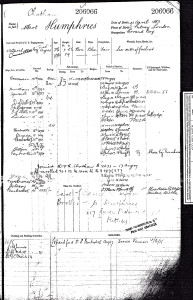
About William Wright
Mr Paul Bendall wrote me about his great grandfather William Wright. William survived. This is the result of our email conversation:
‘Hello, I have found out about the society from a questions page in the Daily Mail regarding the U-boat captain who sank three British light cruisers off the Dutch coast. My great-grandfather, William Wright from Nottingham, was on HMS Hogue when it was sunk, I believe he was a stoker. He was also on HMS Barham in 1919. I can remember him from when I was little, he died in 1968. There was a picture of HMS Hogue on his living room wall which is now proudly hanging in my hallway. I am not sure how he was rescued, he could not swim. I will have to ask my great aunt.’
Next message: ‘I have had a word with my Aunt and my Mother and found a few other things out and have attached a word document.’
And here it is:
‘I have spoken to my Aunt and she has given me a more accurate description of events as well as she can remember them. I have also got a copy of his Naval record. William Wright number K10699, date of birth 29/11/1892, place of birth Redford Nottingham. Joined the Navy on the 28/3/1911 and was at Portsmouth shorebase HMS Victory II as a stoker 2nd class until 22/4/1911.
23/4/1911 until the 10/6/1911 HMS Renown, stoker training ship. Stoker 2nd class
11/6/1911 until the 31/12/1911 HMS Victory II. Stoker 2nd class
1/1/1912 until the 14/3/1912 HMS Jupiter gunnery training ship. Stoker 2nd class
15/3/1912 until the 18/3/1912 HMS Victory II Stoker 2nd class
19/3/1912 until the 12/6/1912 HMS Duke of Edinburgh Stoker 2nd class
13/61912 until the 2/3/1914 HMS Duke of Edinburgh Stoker 1st class
3/3/1914 until the 31/7/1914 HMS Victory II Stoker 1st class
1/8/1914 until the 22/9/1914 HMS Hogue Stoker 1st class
23/9/1914 until the 18/8/1915 HMS Victory II Stoker 1st class
19/8/1915 until the 24/7/1918 HMS Barham Stoker 1st class
25/7/1918 until the 2/4/1919 HMS Barham Acting leading stoker
3/4/1919 until the 31/3/1920 HMS Barham Leading stoker
After the Hogue was sunk he swam to the Cressy after that he was in the water for some time before being picked up by a Dutch trawler. I do not know which trawler picked him up or if he was taken to Holland, he was not injured. I do not know if there is any way to find out if he was on the Flora or on the titan and was transferred to HMS Lucifer. He was the only survivor from Nottingham and when John Dane Player ( players tobacco company of Nottingham) heard he had a photograph commissioned which is hanging in my Great Aunts hallway. His next ship after the Hogue was the new battleship Barham, which was the 5th battle squadrons flag ship based at Scapa Flow. It was on this ship that he saw action in the battle of Jutland. I have also included some pictures of him.’
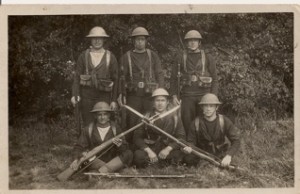
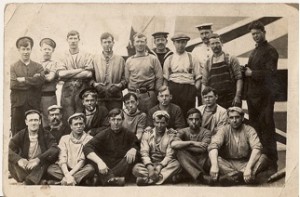
About John Gambrill
Mr Kinn Mcintosh writes to Mrs Tessa Towner of FOMA.
‘In response to your article in the current KFHS Journal, I can tell you that John Gambrill, age 42, was Chief Stoker on HMS Hogue when it went down. His name is on the war memorial in this village, Sturry, near Canterbury. But I know of no descendants nor indeed where in the village he lived.’
I receive a similar answer. But after searching my papers I have this too:
John Gambrill, Chief Stoker, 167791. Age 42, Son of Edward and Harriet Gambrill, of Sturry, Canterbury, husband of Edith L. Gambrill, of 36, Greenfield Rd, Gillingham, Kent.
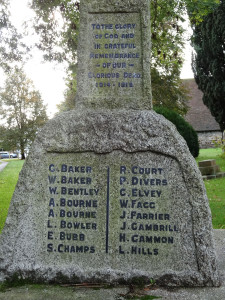
About William Tice
This is William John (1873-1934).
About this picture his Grandson John Tice says: ‘Photograph probably taken in 1914’. And: ‘He was allowed to keep his moustache because he was a reservist!’
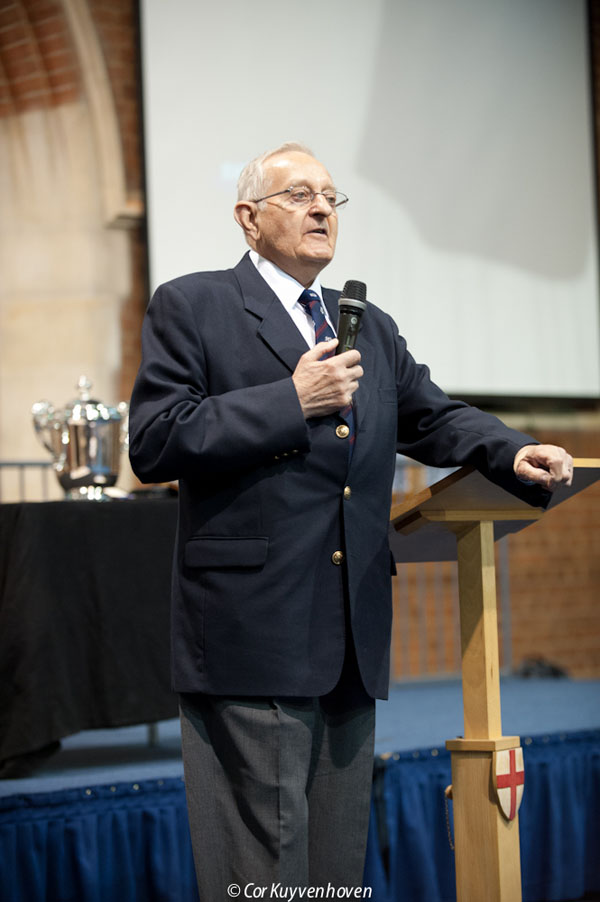
My grandfather, William (“Billy”) Tice was, we understand, a Petty Officer Stoker on H.M.S. Hogue. He had retired from the Royal Navy and had served as a coastguard in Scotland and in Norfolk. As a reservist, he was recalled in 1914 and posted to Chatham where he joined the 7th Cruiser Squadron.
Unusually, he had a large curly moustache, and those who are familiar with naval orders will know that as far as facial hair is concerned, you either have a full beard and moustache or nothing! However, as a reservist, he was allowed to keep his moustache.
The torpedoes struck H.M.S. Hogue at 06.55 and my grandfather managed to abandon ship along with the others who were not killed in the explosions. He was not a tall man, but he was very large around the middle and weighed 23 stones, (322 lbs,) and because of his size he was fairly buoyant, and he was a very good swimmer. He was in the water for about an hour and a half searching for a rescue boat, but when he found one and eventually grasped the gunwale he was told “You’re too big to come aboard,” and he was thrown a rope which he lashed round his waist to be towed astern. He was eventually taken aboard the “Coriander,” one of the fishing boats in the area, and landed, I believe, in Lowestoft. He lived in Gillingham and in Wigmore where he bought a smallholding, and died in 1934 in what was then the Royal Naval Hospital. His coffin was taken by gun carriage, and buried with full naval honours in Woodlands Road cemetary.
About Frederick John Kennett
Mr Malcolm Oatley presents his Grandfather Frederick John Kennett. He was born 31 January 1878 St John’s Margate Kent. According to his record of service his civil occupation prior to entry was Lockman. Date of entry to Boys Service 18 February 1893. On Entry he was of height 5ft 0.5ins, had dark brown hair, brown eyes, dark complexion. It is no surprise that on 31 January 1896 (his 18th birthday), the physical description about height changes: 5ft 2.5ins, but hair, eyes, complexion say the same. New detail:
Personal marks: anchor and heart on back of forearm. Heart with LT+FK and cross on back of left forearm.
His official service number was Chatham 171792.
He survived the disaster of 22 September 1914 and WWI as a whole.
He was demobilized for salvage service on 16 September 1918.
His character: Very good throughout.
Mr. Malcolm Oatley writes me this (19 March 2012).
‘I have been contacted regarding the three ships and I understand you are looking for relations of the crews. My grandfather served on HMS Hogue and was one of the survivors. He swam with the ships ensign around his body and just before the Navy left Chatham Dockyard my Mother gave it back to the last Dockyard Commander’.
‘This photo was taken when my Mother gave the flag back to the last commander of Chatham Dockyard’.
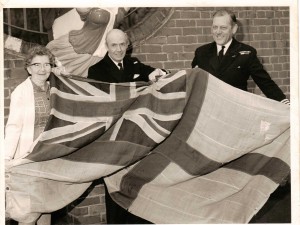
This is part of my (Henk) answer (21 March 2012):
‘Your Grandfather is in my book too. I found a story of an eye-witness. “one very strange incident of the disaster was the way the ensign of the Hogue was saved. I do not know how it happened but one of the stokers who had managed to escape got hold of the ensign when he was in the water, and hung to it all the time he was in – two or three hours. He had the ensign with him when we were in Holland, and had his photograph taken with it in the background.”
The eye-witness did not mention his name. Do you have this photo? If not, as it was in Holland, I will look for it.’
Malcolm answered: ‘Unfortunately I have very little original material. But we did have the ensign and a couple of photographs which survived WW1 bombing and I have my Grandfather’s naval record.’

‘My Grandfather is the chap seated with the goat on his lap. He was a sailmaker. He was on China Station during the Boxer War of 1900.’

‘This one is of him at the end of his first service in 1908’.
(Henk) I still have not found a photo with him and his flag in a Dutch hospital bed.
About Jack Twort
Jack Twort was the Great grandfather of Mrs Sara Bates, from Rochester, who played an important role in the Turning The Page Ceremony on 22 September 2012 in Rochester Cathedral.
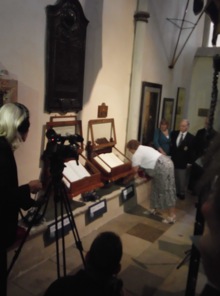 Jack Twort (170842) Royal Navy, was Chief Stoker aboard HMS Hogue. At the time his age was 40. He was the son to Horace and Phyllis Twort, of Tonbridge, Kent. He was the husband of Olive W. Twort, of Gillingham. And this is him (photo sent by Mrs Sara Bates):
Jack Twort (170842) Royal Navy, was Chief Stoker aboard HMS Hogue. At the time his age was 40. He was the son to Horace and Phyllis Twort, of Tonbridge, Kent. He was the husband of Olive W. Twort, of Gillingham. And this is him (photo sent by Mrs Sara Bates):
About William Alfred Fox
William is presented by Mr. Matt Pearce, William was his Great Grandfather. This is his story:
‘My grandfather, who like his father also served in the Royal Navy for over 35 years used to tell me the story of how his father died. I can remember him reading me extracts from the book “Three before breakfast” all about how he lost his father, and can remember how fascinating I found the story. I have my Great Grandfather’s service record. Before my Grandfather passed away in 1993 he gave me his fathers medal and the brass plaque that my Great Grandmother received as a result of my Great Grandfather drowning.’
The details I (Henk) have are William Alfred Fox, Stoker 1st class, SS/101584. (RTR/CH/B/7020), Royal Navy, age 27.
Mr Pearce continues his story about William:
‘Born 2 June 1887. Clerkenwell, London. He was a Brass finisher. He was on the Hogue from 2 August 1914. He was 5ft, 3.5 inches tall, hair light brown, eyes gray, complexion fresh. Scar right side. As far of the rest of my family is concerned, they pretty much all lived in Kent in the Chatham and Gillingham area. My grandfather joined the Naval College in Greenwich, London at about the age of 14 I think, as a result of my Great Grandmother struggling to support a family due to the loss of my Great Grandfather. He later returned to Kent and spent the rest of his life in the Gillingham area of Kent where my mother grew up. My father grew up in Chatham so they know the area well. I grew up in Surrey the county next to Kent so remember regular visits to Kent as a child and teenager and was often taken to the Naval Memorial in Chatham and could see it clearly from my Grandmother’s house in Chatham. Though I must have been too young to remember if they pointed out my Great Grandfathers name at the Memorial. My grandfather followed in his fathers footsteps and also joined the Navy and served during the second world war and in total served for 35 years and was ranked as Chief Petty Officer at the end of his career. I remember the stories he used to tell us of what life was like serving during the second world war, escorting the Russian Convoys in the bleak sea around Northern Russia and the North Atlantic.’
About Arthur Hopcraft
Mr. Graham Hopcraft is the Great Great Grandson of Arhur Hopcraft. Mr Hopcraft and his family attended with six persons at the ceremonies 22 September 2012 Rochester/Chatham.
Arthur William Hopcraft was an able seaman, 182221 (RFR/CH/B/5691). Royal Navy. Age 36. Husband of Elisabeth Hopcraft, of West Norwood, London.
About David Emmanuel Scott
David Emmanuel Scott was a merchant seaman from Westmoreland, Jamaica. Born in 1865 he volunteered for service with the Royal Navy in 1892 and served on the depot ship HMS Urgent. He came to England around 1900 and joined the RNVR at the outbreak of hostilities. He served just briefly on the Hogue. Unfortunately he was killed in a boating accident at Scapa Flow on 24th August 1914.
(Presented by Mr David Scott)
(Commentary Henk) When mobilised 27th July 1914 mobilisation Mr Scott was one of over 700 crew boarding HMS Hogue. He performed his duty just like the others did; many of the crew members worked together with him as colleagues and were acquainted with him; so his memory should be honoured here too, as it would had he shared the ill fate of his fellow crewmembers.
About Cuthbert Black
Mr Cuthbert Thomas Black is presented by Mrs Laura Briggs. She wrote me this:
‘My mother is Janet Black, whose father Arthur William Black was Cuthbert’s cousin. My grandfather died in 1974 so I am unable to pass on any of his memories of Cuthbert. I was contacted by George Hornby who also lost an ancestor on the Hogue (Henk: she refers to Joseph Leonard Edmonds) and whose wife’s grandfather was a second cousin of Cuthbert’s.
Cuthbert Thomas Black, able seaman, 2249922, Royal Navy, Age 26. Son of Francis and Mary Black, of 127 Grange Rd, Plaistow, London. He was born at Gravesend, Kent.
About Joseph Leonard Edmonds
At St George’s on 22 September 2012, Mr George Hornby was meant to be on the Speakers list. I cannot possibly recall how it happened, but I somehow failed to invite him to come forward and tell his story. I really felt very bad about this, but Mr Hornby assured me ‘no harm done’, and I promised to have his story inserted in this Bulletin. And here it is:
Chief Petty Officer Joseph Leonard Edmonds was a gunner aboard HMS Hogue. He did not survive its loss.
He was 41 and had been born in the Chiltern Hills, where his mother was a 24-year old straw plaiter, recently married to a 40-year old gardener. The couple soon bought a small house in Harrow Weald. They were Downstairs people who knew how to talk to Upstairs people. Young Joseph may have heard about his grandfather fighting at Waterloo. He himself opted instead for the Royal Navy at an early age and became a specialist gunner.
Over time he became hairier. He began with just a trim moustache on its own. Later he had a tiny chin goatee with magnificent waxed moustaches that were wider than his head. Eventually he settled down with this rather fashionably regal appearance.
He married Kate Davis, whose family were all in the service of the Duke of Beaufort at Badminton. Her sister, a retired housemaid, was to hold frequent conversations with the dowager Queen Mary. This Downstairs who could indeed handle Upstairs.
His postings took the growing family to Sheerness, where he was a gunnery instructor, and to Lerwick in Shetland.
In 1908 they bought a new two-up two-down in Chaucer Road Gillingham; Kate lived there for half a century. His portrait hung on the chimney breast, the room’s focal point, all that time. His image (parade uniform, medals, total confidence) dominated the room and the thoughts of family and visitors throughout that time.
Chief Petty Officer Edmonds left his four children and pregnant wife in this house, and went to his next long posting. This time as far away as possible: the China Station. He was second in command of HMS Sandpiper, the Royal Navy’s smallest warship. A gunboat with 21 crew, Sandpiper’s main beat was the Yangtze River plus frequent visits to Hong Kong and Canton, as he called it, as well as up other Chinese rivers. In October 1911 the Xinhai Revolution broke out, with Shanghai on the Yangtze as its epicentre. This revolution ended the Chinese Monarchy. Family legend states Edmonds was involved in rescues ashore during this revolution.
The most vivid souvenir he brought home from China was a pair of beautifully ornate shoes for an adult woman. Her feet were bound and broken so as to restrict the foot’s length to 4” (10 cm), the same size as her ankle’s width. He brought it back to Medway, where he was posted to HMS Hogue.
Joseph Leonard Edmonds was a very keen Freemason. Fortunately. After his death masonic charities helped support the family. Most notably they put his youngest daughter through the Pitman Secretarial College in Rock Avenue, and his youngest two sons through Gillingham Technical High School, qualifying them for good careers in the regular armed services. For some strange reason they did not choose the Navy; instead they became aircrew in the Royal Air Force. One was killed in action by the Kurds in modern Iraq in 1932. Both the Chief Petty Officer’s daughters married very able skilled working men, one a Royal Engineer, the other a Dockyard shipwright.
His widow, Kate, a particularly fierce and uncompromising lady, kept Joseph Leonard Edmonds’ portrait in its dominant position until she died in 1961.
As a footnote, this: two families who lost men on the Hogue were united by marriage in 1978. Joseph Leonard Edmonds’ great grandson married the second cousin, twice removed, of Cuthbert Thomas Black, a 26-year old Able Seaman. Cuthbert had been born in Gravesend, the second son of Francis Cuthbert Black, a steam tug engineer on the Thames.
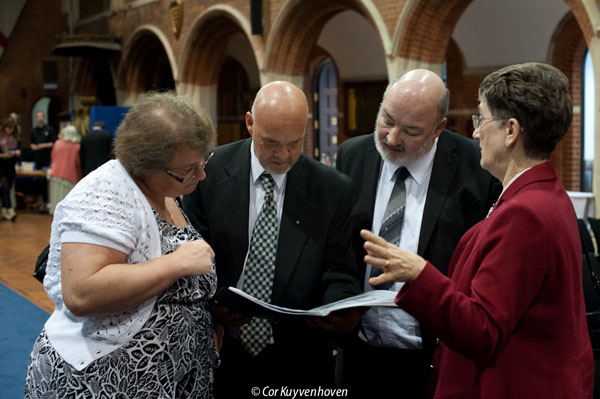
About Henry Arnold
Henry was Stoker First Class, 297700 (RFR/CH/B/9798). Royal Navy. Son of George and Mary Ann Arnold, of 16, Fingal S., East Greenwich, husband of Lillian Ethel Arnold, of 14, Fingal St., East Greenwich, London.
Mrs. Kay Weeden writes me this: ‘My dad was born in 1915 in 1915 and his dad died when he was twelve. His most vivid memory of him was the impact the death of his brother Henry had on him and the family when the ship he was on was sunk. About a year after my dad died in 1998 a cousin found out that Henry’s name was on the Chatham Memorial. My husband and I went and saw it and I was so sad that my dad had lived only a ten minutes drive away from the Memorial not knowing. He would have been very proud. Knowing this you can imagine the impact of the article in our local paper about the service in Rochester Cathedral had on me. I was so grateful that John Tice rang me and passed my details to you. It is very likely that his grandfather and my great uncle worked near one another on the ship and knew each other. I knew nothing about the other two ships being sunk’.
About Wilson Steele
Wilson Steele was a Stoker 1st Class, K/11446, age 29. Son of Lucy A. Fowler of High Street Clifford, Boston Spa, Yorkshire.
Mrs Carolyn Clemo writes me: ‘I read on the Navy News that you are trying to trace relatives of those killed on HMS Aboukir, Hogue and Cressy. My mother is a niece of Wilson Steele, a stoker on board HMS Hogue who was killed when the ship sank at the age of 29. She didn’t know Wilson personally, he died before she was born but has memories of his mother talking about her two boys. Wilsons brother Alfred Fowler was later called up into the land forces and was killed at the Battle of Cambrai in 1917, aged just 19.
Wilson was a navy regular who joined the service in 1906 and from his service record he served on a number of ships before joining HMS Hogue in August 1914, just 1 month before its sinking.
Wilson was originally from the country of North Yorkshire, his father was a gamekeeper and it appears from the 1901 census that he helped his father in this occupation; according to his service record though he was working for a local brewery at the time he joined the Navy.’
About Harry Hammond
Harry Hammond is remembered at the Chatham Memorial. He was a blacksmith, 341183, Royal Navy, age 40. Long service and Good Conduct Medal. Son of George and Ann Hammond, of Hove. Husband of Alice M. Hammond, of 1. Suffolk Street, Hove, Sussex.
Miss Hazel Ferran writes this: ‘My Great Uncle Harry Hammond went down with the Hogue. He was my great grandmothers brother. I am hoping someone may have any photos of the men who were on the Hogue as I do not have any of Harry. I have a photo of his son who also went into the navy and the photo is of him in his naval uniform and I would say he looks a lot like his dad, as with having Harry’s navy records it say what colour hair and eyes he had.’

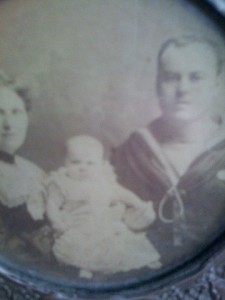






My Great Grandfather was “Walter Charles Wood” (Service Number 175564), he served from 1895 – to 1919 (less a short period out), he served on many different great ships of the period but his greatest affinity was i believe to the Hogue, he named one of his Daughters “Sybil Hogue Wood” and the family history/lore is that following his service he was not a well man, from the descriptions and from his Service Record i believe that this will have been due to PTSD (or Shell Shock) due to his experiences during the events of 22nd September 1914.
I have his Medals, his “Diddy Box” and a PDF of his Service Record from the National Archives (which i am struggling to make sense of), i also have been lucky enough to find a book of the “Live Bait Squadron” with a chapter in his own words regards the events on that day which talks about how he was awoken from his Hammock with an explosion, how he made it to the decks and saw what was happening with his own eyes, and a further explosion very close to where he stood and where one of his officers literally disappeared in front of his him in the Explosion before apparently coming to and in the water making his way to the “safety” of HMS Cressy, he got on board before she too was lost and then finding himself being rescued by a Dutch merchantman and being taken to Holland before returning to the UK and continuing his service
I am keen to find anything more i can on my Great Grandfather as i want to fully document what i can based on the variety of documents out there and i would love to find a photo of him from the period, in addition i desperately want to find out about the period of his internment in Holland prior to returning to duty during the war.
I look forward to any further information you can provide.
I’m related to Thomas Burchill 276152 who was one of the Leading Stokers on HMS Hogue.
I have his service record, and his 1914/5 Star.
I’d be delighted to hear any information you may have of him?
Many thanks,
Paul
I would love to hear about William Swainland please
My grandfather, James H Walton married Amelia Ansell . They had 2 sons , Walter and Charles.
I’ve been told Walter served on HMS Cressy and Charles on HMS Hogue. Both submarines were sunk on 22/9/1914 and both lives lost on the same day!
Can anyone verify this story please
My name is Richard Smailes and my Great Grandmother was Florence Elizabeth Fox. I have recently found out that her brother, William Alfred Fox, was a Stoker on the ill fated HMS Hogue which was sunk by a German U Boat torpedo on 22nd September 1914.
I am fascinated by the story and the fact that I have a connection with a part of history I was unaware of until recently. I would like to learn more about what happened, but more specifically would like to get to know more about my Great Grand Uncle. If anyone has a named photograph with him on, I would be especially pleased.
Many thanks.
Hello I am the founder of http://www.claytonandwhittleatwar.co.uk
A profile of Thomas Feeney is on my website in the Miscellaneous Personnel section with a bit of a question mark over him as I’ve been trying to confirm where he was just prior to his death
By chance, I found a notice in the Lancashire Evening Post from Wednesday 7 October 1914-
Among those drowned in the sinking of H.M.S Hogue was T. Feeny, Leading Signaller whose home was at Clayton Green
Feeney had been transferred to the HMS Hogue three days before the ship was sunk.
NEED TO INVESTIGATE THIS MORE AS BY THE TIME OF HIS DEATH HIS WIDOWS ADDRESS IS 103 ALKER STREET, BLACKBURN.
IN 1901 HE IS LIVING AT CLAYTON LE WOODS WITH PARENTS AND SIBLINGS INCLUDING JAMES FEENEY (KIA AND ON LOCAL MEMORIAL).
HE JOINED THE NAVY ON 13 MAY 1904.
IN 1911 HE IS SINGLE AND STATIONED AT THE ROYAL NAVAL BARRACKS, CHATHAM.
IN 1914, PERHAPS HE WAS LIVING IN CLAYTON GREEN AS OF SIGNING UP FOR WW1.
THEN MOVED WITH HIS NEW WIFE, MARGARET, TO BLACKBURN.
HIS MOTHER NELLIE FEENEY IS STILL LISTED AS LIVING IN CLAYTON GREEN AS OF THE 1915 ELECTORAL REGISTER.
HE GOT MARRIED TO MARGARET PEMBERTON IN 1914 AT THE BLACKBURN REGISTER OFFICE.
THE NEWSPAPER CLIPPING CLEARLY STATES –
Among those drowned in the sinking of H.M.S Hogue was T. Feeny, Leading Signaller whose home was at Clayton Green.
Feeney had been transferred to the Hogue three days before the ship was sunk.
SO MAYBE THE ADDRESS, 103 ALKER STREET, BLACKBURN IS WHERE HE INTENDED TO LIVE AFTER SERVICE, OR SHE MOVED THERE AFTER THOMAS FEENEY HAD DIED?
HIS NAME DOES NOT APPEAR TO BE INCLUDED ON THE BLACKBURN ROLL OF HONOUR, OR THE WHITTLE LE WOODS 1914 – 1915 ROLL OF HONOUR.
NOR IS IT ON THE CLAYTON LE WOODS, CHURCH OF ENGLAND SCHOOL 1914 – 1918 ROLL OF HONOUR OR THE WHITTLE LE WOODS WESLEYAN SUNDAY SCHOOL 1914 – 1918 ROLL OF HONOUR.
ONLY HIS BROTHER JAMES FEENEY’S NAME IS ON THE WHITTLE LE WOODS 1914 – 1915 ROLL OF HONOUR.
Thanks
John Melling